김선두 개인전
2024. 6. 11 - 8. 22 | [GALLERIES] GalleryMEME
김선두

김선두, 낮별-꼬깔콘, 172 x 140 cm, 장지에먹
현대화로서의 한국화에 대한 고민과 실험을 거듭하며 전통기법과 현대적 감각이 결합된 독자적 화풍을 구축해온 김선두 작가의 개인전이 6월11일부터 8월22일까지 갤러리밈에서 열린다. 갤러리밈 개관 10주년 기념으로 기획된 전시로, 일상풍경 속에서 만나는 자연을 생명이라는 존재의 본질로 들여다보고 때로는 욕망에 휘둘리는 우리의 모습을 투영해 내면서 삶과 예술에 대한 사유로 확장되어가는 작품세계를 펼쳐낸다.
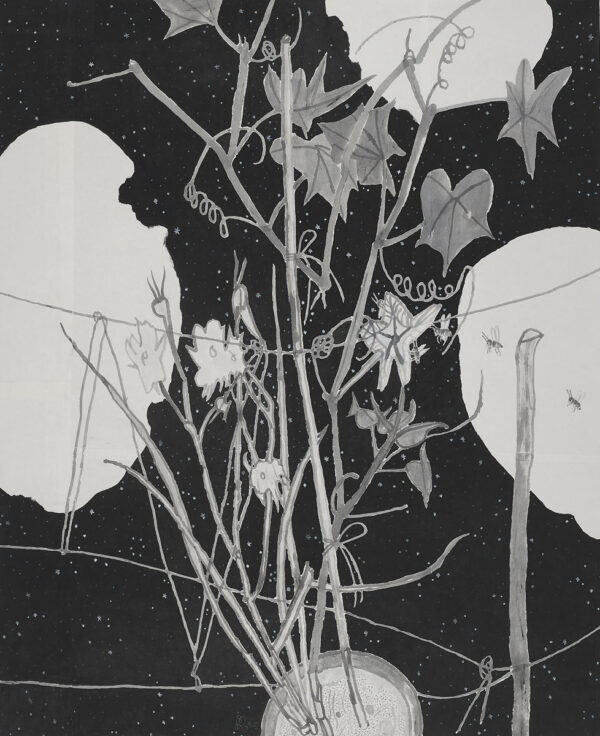
김선두, 낮별-꿀벌들, 130 x 162 cm, 2025
이번 전시에서 연작으로 발표하는 ‘지지 않는 꽃’ 시리즈는 도시의 여느 동네에서나 만날 법한 벽화 속 꽃 그림과 그 벽면 언저리에서 뿌리내린 풀꽃의 대비로 두 세계의 함의를 교차시킨다. 변하지 않는 절대적 실체를 은유하는 벽화 속 꽃 이미지는 불변의 이념 속에 갇혀있는 박제된 존재로, 바람과 비에 흔들리면서도 기어코 꽃을 피우는 달개비나 맨드라미는 변화와 순환이라는 생명의 본질을 끈질기게 살아내는 존재로 대비시키며 ‘지지 않는 꽃’이 품고 있는 진정한 영원성을 드러낸다.
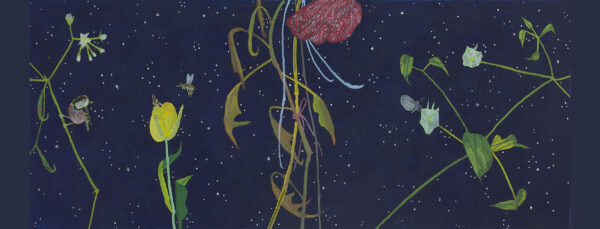
김선두, 낮별-맨드라미, 167 x 71 cm, 2025
짙푸른 어둠 가득찬 들녘을 홀로 걸어가는 사내와 보름달로 동반의 관계를 서정적으로 길어올린 ‘밤길’, 우리가 쉽게 놓치는 삶의 본질을 낮에는 보이지 않는 별로 풀어낸 ‘낮별’, 지나온 자리를 돌아볼 때 비로소 놓쳤던 순간들의 의미를 깨닫게 되는 ‘느린 풍경’ 등 김선두 작가의 대표적 연작의 신작들을 발표한다.
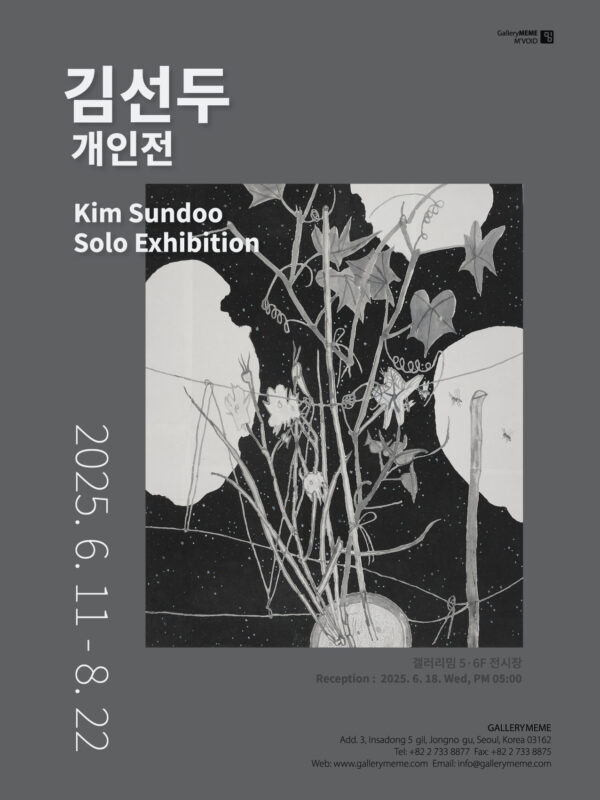
김선두 개인전 포스터
전시 서문 “황홀한 세상의 누추한 삶에 대한 찬가”
김선두의 작품은 일종의 트릭을 갖추고 있다. 동양화인지 드로잉인지 알아보지 못하게 하는 면도 그렇지만 ‘일부러 못 그린 잘 그린 그림’ 전략이다. 예술의 최고의 경지란 실지로 기능적으로 완벽함을 추구한 지점은 아니어서 가장 본원적인 상태, 천진난만함의 절정이 바로 그 경지라고 한다. 이를 적용시켜 이해해보자면, 추사 김정희의 어린아이 글씨처럼 보이게 한 동자체(童子體)나 일본의 헤타우마(へたうま)가 해당할 것이다. 대교약졸(大巧若拙), 보통사람의 눈에는 그리 뛰어난 기교를 사용하지 않고, 마치 스케치하듯 그려진 그림들은 사실 바탕이 쫀쫀한 장지에 채색을 올리고 또 올려서 나타낸 색채이며 형태이다. 졸(卒)의 모습을 띤 장(將), 그것이 바로 노회함에 이른 김선두 화면의 특징이다.
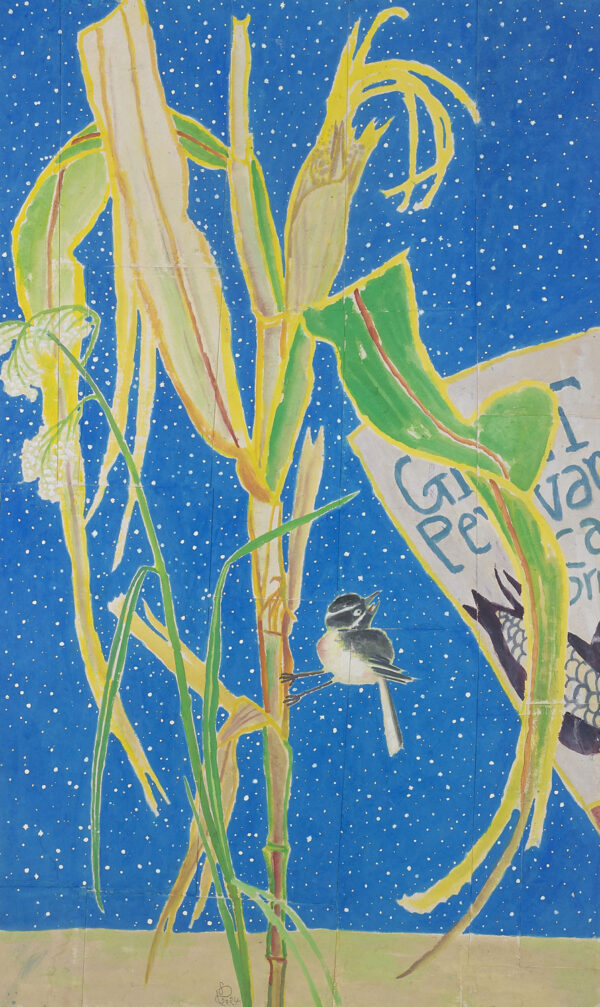
김선두, 낮별-옥수수, 장지에 분채, 76x127cm, 2024
그의 화면이 비유와 설화 그리고 교훈으로 가득한 서화의 전통을 깨고 나와 낙서처럼, 어린아이 그림처럼 보이는 것은 그의 작품이 대개의 한국화가 사용하는 것과는 다른 방식으로 구성되어 있기 때문이다. 가장 눈에 띄는 것이 시점이다. 새가 되어 세상을 내려다보는 관조의 세계가 아니라, 시들어 빠진 해바라기 줄기 아래에서 먹이랍시고 과자부스러기를 발견하고는 즐거워서 고개를 들어 위를 올려다본 개미마냥 하늘은 높고 꽃대는 크다. 의도치 않게 그의 작품 안 저 낮은 곳에 있는 너무나 미미한 어떤 것과 눈을 마주치게 되고 그것에 이입하여 세상을 바라보게 되는 것이다. 붕새의 날개짓을 꿈꾸기는커녕 눈에 뵈지도 않는 미미함이 바로 자신임을 깨닫게 되는 순간이다. 부감법으로 세상을 관조하는 동양화의 전통과는 반대로 그의 작품은 관람자를 바닥에 내려놓고 허위의식을 벗고 세상을 바라보게 한다.
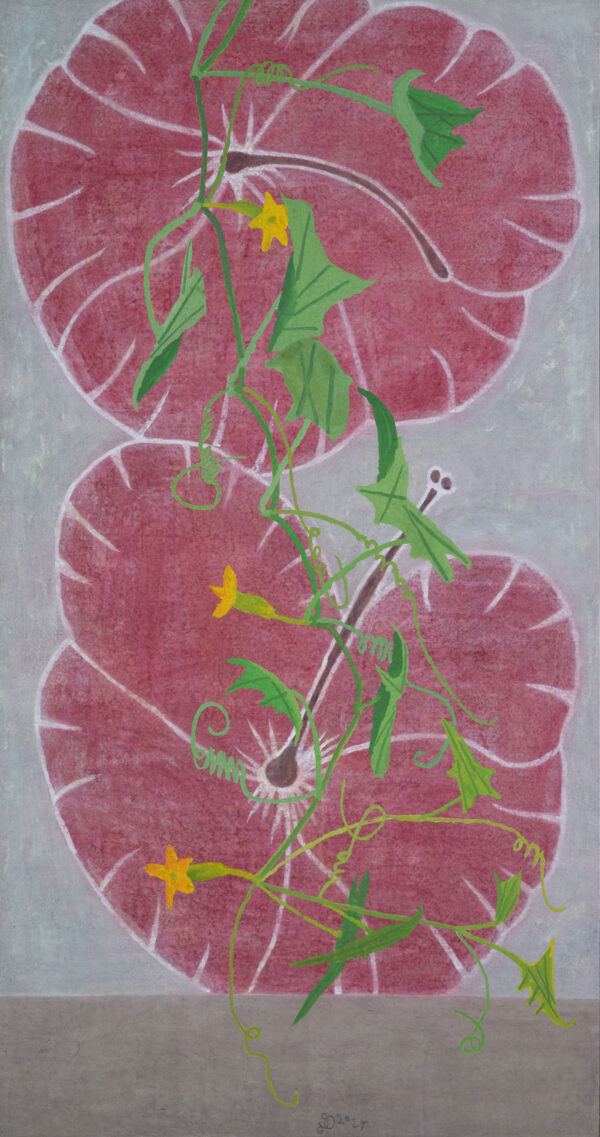
김선두, 지지않는 꽃, 75 x 143 cm, 장지에 분채, 2024
본다는 것은 자신의 존재를 규정하는 방법이다. 눈에 보이는 것들을 통해 내가 놓인 곳, 나를 둘러싼 풍경과 존재를 통해 나의 위치와 상황을 알게 된다. 달은 하늘에 언제나 있지만 홍운탁월(洪雲托月), 구름으로 존재를 드러내는 오래된 그림의 방법처럼 나는 내가 바라보는 것들로 구성된다. 앞으로 나아가기만 할 때는 볼 수 있는 것은 없기에 자신을 알 수 없다. 그의 <느린 풍경> 시리즈는 속도를 제거한 풍경, 즉 자신이 존재하는 공간, 그래서 재현된 삶의 모습이자 작가의 공간적 위치이며 자연을 통해 비유된 작가의 존재성이다.
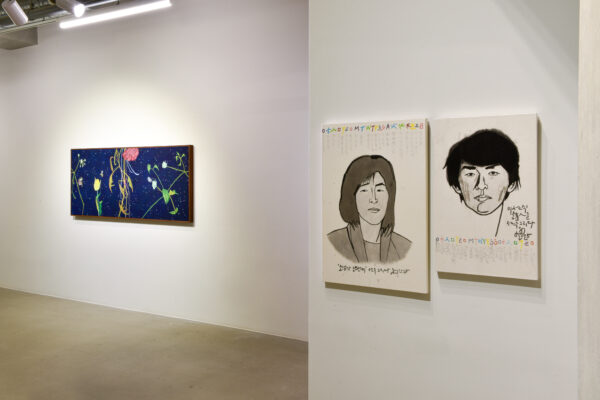
전시 전경 (1)
<낮별> 시리즈는 여행의 경험에서 시작되었다고 한다. 산골 속에 위치한 숙소 창에는 밤새 하늘 가득히 쏟아질 듯 넘치던 별들이 있었다. 도시에서 보지 못한 풍경은 추억을 소환하였고, 총총한 별들은 맘을 흔들어 잠들지 못하게 하였건만, 아침 해가 밝자 서서히 사라져갔다. 또렷했던 별의 자취는 온데간데 없어진 낮, 여전히 하늘에 별이 있다는 것을 알지만 눈에 보이지 않았다. 그래서 낮에 그려진 별은 변하지 않는 본질에 대한 상념이다.
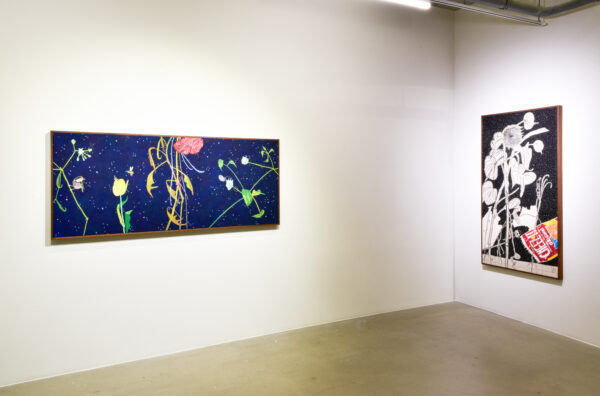
전시 전경 (2)
하늘에 흩뿌려진 별들을 배경으로 꽃이 피고, 고양이가 움직이고, 새가 부리를 드러낸다. 화조영모(花鳥翎毛)의 화목을 벗어나지 않으나 그의 그림은 일러스트처럼 이야기를 걸고, 시시콜콜 동시대의 먹거리를 보여주기도 한다. 포스트모던의 언어를 담은 그의 화면은 동시대의 화법을 소화하면서 또한 오래된 그림의 역할인 삶에 대한 성찰의 끈을 조여온다. 새는 꽃을 희롱하는 것이 아니라 먹다버린 과자봉지를 콕콕 쪼고 있다. 현대 도시인의 삶에 대한 은유가 바닥에 나뒹구는 과자봉지를 탐하는 새로 구현된 것이다.
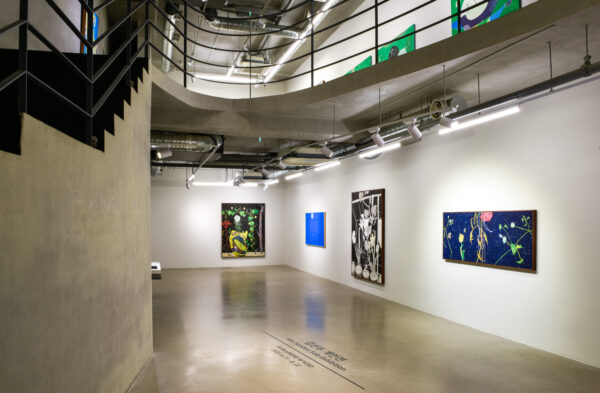
전시 전경 (3)
김선두가 보여주는 인물은 대부분 우리가 알려고 하면 알아낼 수 있는 이들이다. 익명의 존재가 아니라 열심히 전문가로서 살아가는 이들이 대다수이다. 그들의 초상화를 일러 <아름다운 시절>이라 이름하였다. 경기를 이긴 순간의 운동선수는 보는 사람을 매료시키는데 그의 성취감 아래서 신체의 에너지, 승리의 기쁨, 빛나는 자신감과 같은 것들이 폭발하는 순간이기 때문이다. 인간 최고조에 달한 순간의 아름다움은 빛나는 것이지만 그의 작품 속 인물들은 웃음으로 가득한 것은 아니다. 그 자신의 모습 그대로 근엄하거나 일그러진 얼굴인 경우도 있는데, 언뜻 스쳐가는 허무의 순간을 포착한 때문이다.
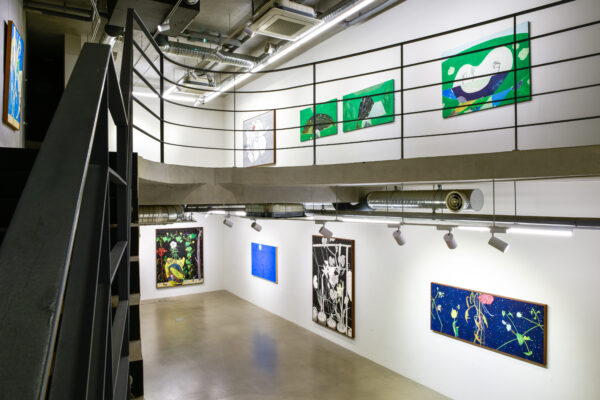
전시 전경 (4)
삶은 누구에게나 어렵고 힘든 혼자만의 길이다. 힘겨운 여정이 눈에 밟히는 <밤길> 시리즈는 어린 시절 어두운 밤에 혼자 가던 길은 무서웠지만 보름달이 뜨면 든든했던 기억을 상기하여 제작한 작품이다. 하늘에 두둥실 뜬 달은 지구상 어디서든 보이겠지만 밤길을 걷는 사람은 아주 작은 존재이다. 고달프고 어려운 삶의 여정에서 보름달을 만난다는 것은 삶을 밝히는 존재를 만나는 것이다. 그것이 사람이든 예술이든, 욕망이든 지속적으로 길을 걷게 하는 힘일 것임은 물론이다.
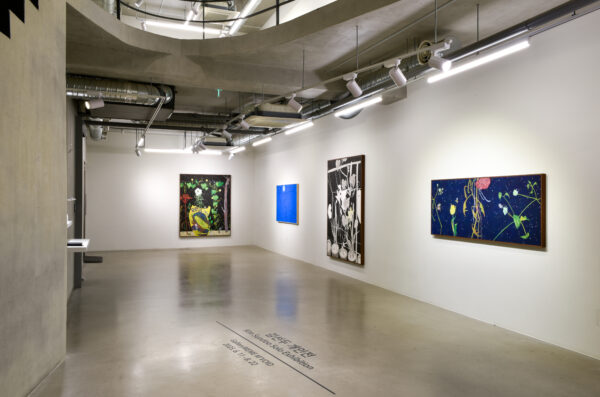
전시 전경 (5)
그의 작품은 보기드문 스펙터클함과 황홀함, 그리고 생을 성찰하는 관조를 내용으로 한다. 가볍고 아름답고 정겨운 작품들은 동시대성 구현이라는 동양화의 과제를 다방면으로 수행하며, 생을 관통하는 신념으로 사회와 삶을 통찰하는 진지함으로 구성된 것이다. 세상에 만만한 것은 없다. 작가의 노동시간을 먹고 몸집을 키워낸 그림들은 생에 대한 물음의 웅장한 소리로 관찰자의 귀를 먹먹하게 한다.
조은정(미술평론, 미술사학)
갤러리밈
서울시 종로구 인사동5길 3
+82 2 733 8877
[GALLERIES] GalleryMEME
- Address
- 서울시 종로구 인사동5길 3
- Dates
- 2024. 6. 11 - 8. 22
- Artists
- 김선두











